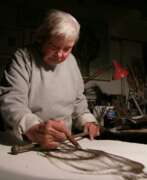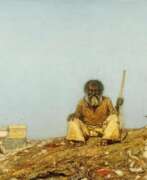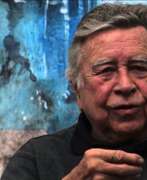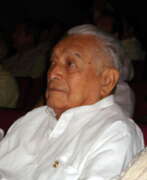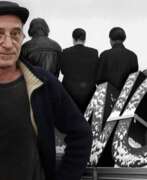Mexico Contemporary art
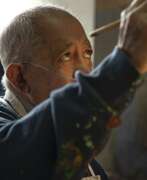

Gilberto Aceves Navarro was a Mexican painter and sculptor and a professor at the Escuela Nacional de Artes Plásticas and Academy of San Carlos. There have been more than two hundred individual exhibits of his work, with his murals found in Mexico, Japan and the United States. He received numerous awards for his work including grants as a Creador Artístico of the Sistema Nacional de Creadores de Arte, Premio Nacional de Ciencias y Artes and Bellas Artes Medal from the Instituto Nacional de Bellas Artes.


Luis M. Alonzo-Barkigia is a contemporary Mexican artist. He studied at the Malmö Academy of Art (Sweden) and at the University of Illinois at Chicago. He was awarded the UIC Presidential Fellowship, the Larsen Fellowship for Studio Arts.


Francis Alÿs is a Belgian-born, Mexico-based artist.
His work emerges in the interdisciplinary space of art, architecture, and social practice. In 1986, Alÿs left behind his profession as an architect and relocated to Mexico City.
He has created a diverse body of artwork and performance art that explores urban tensions and geopolitics. Employing a broad range of media, from painting to performance, his works examine the tension between politics and poetics, individual action and impotence.


James Brown was an American-born painter active in Paris and Oaxaca, Mexico. He was most well known in the 1980s for his rough painterly semi-figurative paintings, bearing affinities to Jean-Michel Basquiat and East Village painting of the time, but with influences from primitive art and classical Western modernism. His work has taken on several styles over the years but maintains a hand-made look combining concerns of the modernist tradition with motifs and spiritual interests from tribal art. Much of his work is a non-realistic but contains depictions or signs of recognizable faces or objects. However, the line between representation and abstraction is often a difficult one in his work. Besides paintings Brown has also produced sculptures and series of prints at various points in his career, and in the 1990s started to heavily utilize collage.


Leonora Carrington was a British-born Mexican artist, surrealist painter, and novelist. She lived most of her adult life in Mexico City and was one of the last surviving participants in the surrealist movement of the 1930s. Carrington was also a founding member of the women's liberation movement in Mexico during the 1970s.


Alfredo Castañeda was a Mexican surrealist painter.
Castañeda had been interested in painting and drawing since childhood, but first became an architect, earning a degree in architecture from the University of Mexico. During his studies, he continued to paint as a hobby, which he became more and more serious about over the years. At university, Alfredo became acquainted with the painter, sculptor and architect Matthias Goeritz, as well as the work of René Magritte. Both played a huge role in the young artist's worldview.
After his studies, Castañeda worked as an architect and in 1969 had his first solo exhibition at Galeria de Arte Mexicano. His work has also been shown internationally numerous times in the United States and in many Latin American countries, including Mexico. His work is collected in collections and museums throughout the Americas, Europe and Asia.
Alfredo Castañeda is known for his surrealist paintings, often portraits. The same character appears in many of his paintings, sometimes revealed in multiple versions of himself. This person (often resembling the artist himself) seems to be engaged in an endless dialog with himself, involving the viewer as well.


Pedro Coronel Arroyo was a Mexican sculptor and painter, part of the Generación de la Ruptura, bringing innovation into Mexican art in the mid 20th century. Coronel’s training was with artists of the Mexican muralism tradition, with influence from artists like Diego Rivera. This influence remained with the use of pre Hispanic themes and colors in his work. However, his artistic trajectory took him towards more use of color and more abstract forms in his work, due to influences from artists such as Rufino Tamayo. His work was exhibited and gained recognition in Mexico, the United States and Europe. Shortly before his death, he donated his considerable personal art collection to the people of Mexico, which was used to open the Museo Pedro Coronel in the city of Zacatecas.


Juan Manuel de la Rosa is a painter, engraver, and ceramicist known for his works on handmade paper. He studied lesser-known techniques for painting and papermaking from Japan, Egypt, Fiyi and France; his handmade paper is typically made of linen, cotton, or hemp. With these traditional approaches, he creates layers and adds new dimensions to his artworks.


Julio Galán was a Mexican artist and architect. Galán was one of Latin America's neo-expressionist painters of the end of the last century and the beginning of this one. His paintings and collages are full of elements that usually represent his life.


Werner Mathias Goeritz Brunner was a Mexican painter and sculptor of German origin. After spending much of the 1940s in North Africa and Spain, he and his wife, photographer Marianne Gast, immigrated to Mexico in 1949.
In 1953 he first presented his "Manifiesto de la Arquitectura Emocional" (Emotional Architecture Manifesto) at the pre-inauguration of the Museo Experimental El Eco in Mexico City, which he designed in 1952-53. During the 1950s, Goeritz also collaborated with Luis Barragán to make monumental abstract sculptures in reinforced concrete, including El animal del Pedregal (The Animal of the Pedregal, 1951) and the Torres de la Ciudad Satélite (Towers of Satellite City, 1957).


Judith Gutiérrez Moscoso was an Ecuadorian painter who lived and worked in Ecuador and Mexico. Along with other female artists, she formed part of the Guayaquil School for Contemporary Plastic Arts (Escuela de Guayaquil en las Artes Plásticas Contemporáneas) and was active in militant groups such as the Union of the Women of Guayas (Unión de Mujeres del Guayas), a precursor to Ecuadorian feminist organizations.


Tamara Łempicka (born Tamara Rosalia Gurwik-Górska), better known as Tamara de Lempicka, was a Polish painter who spent her working life in France and the United States. She is best known for her polished Art Deco portraits of aristocrats and the wealthy, and for her highly stylized paintings of nudes.


Raymundo Martinez is a Mexican landscape painter and printmaker. His subject matter is the reinterpretation of the Mexican landscape: he painted the vast expanse of land, creating an ideal environment for the rapid growth of the metropolis.
The president of the country, Adolfo López Mateos, was a patron of the artist from 1958 to 1964 and willingly presented his works to heads of state. The works of Raimundo Martínez can be found in various Mexican embassies around the world, as well as in the collections of national political figures.
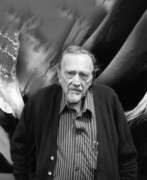

Leonardo Nierman, full name Leonardo Nierman Mendelejis, is a Mexican artist known mainly for his paintings and sculptures. His work is abstract yet still contains visible images of nature such as birds, water, lightning and more. His paintings are in pure colours, while his sculptures are usually in metal, often with a silver hue.


Gabriel Orozco is a Mexican artist. He gained his reputation in the early 1990s with his exploration of drawing, photography, sculpture and installation. In 1998, Francesco Bonami called Orozco «one of the most influential artists of this decade, and probably the next one too».


Hilda Paredes is a composer originally from Mexico, mainly living and working in London.
After studying at the Conservatory of Music in Mexico City, Hilda Paredes earned a Master of Arts degree at City University in London and a doctorate at the University of Manchester under the supervision of Professor John Casken. She has been living and working in London for some 40 years, but continues to be involved in the musical life of her native Mexico as a composer and teacher. Hilda has taught composition and lectured at the University of Manchester, the University of California San Diego, and the University of Buffalo.
Although there is evidence of the presence of Mexican art in her works, Hilda Paredes also draws inspiration from many composers and cultures from around the world. Her music has been critically acclaimed for its refinement of craftsmanship, dramatic power, and poetic approach. Hilda incorporates a wide range of electroacoustic elements into her works.
One of Paredes' most internationally acclaimed works is the chamber opera Harriet. It has been performed in Mexico, the UK, France and Belgium. For this work, Hilda was awarded the prestigious Ivors Composer Award 2019 (formerly British Composer Awards).


Sebastián, born Enrique Carbajal González, is a renowned Mexican artist known for his monumental sculptures and public art installations. His works often combine elements of abstraction and geometric forms to create visually striking and dynamic compositions.
Sebastian's sculptures can be seen in cities around the world, including Mexico City, Houston, Paris, Tokyo, and more. His large-scale works serve as landmarks and symbols of cultural identity, demonstrating his ability to merge art with the urban landscape.
Sebastian's works often address themes of movement, balance and harmony, inviting viewers to interact with their environment and reflect on the relationship between art and public spaces. With his profound artistic vision and extensive artistic legacy, Sebastian has had a significant influence on contemporary sculpture and has cemented his position as a prominent figure in the art world.


Rufino del Carmen Arellanes Tamayo was a Mexican painter of Zapotec heritage, born in Oaxaca de Juárez, Mexico. Tamayo was active in the mid-20th century in Mexico and New York, painting figurative abstraction with surrealist influences.


Francisco Benjamín López Toledo was a Mexican Zapotec painter, sculptor, and graphic artist. In a career that spanned seven decades, Toledo produced thousands of works of art and became widely regarded as one of Mexico's most important contemporary artists. An activist as well as an artist, he promoted the artistic culture and heritage of Oaxaca state. Toledo was considered part of the Breakaway Generation of Mexican art.


Danh Vo, birth name Võ Trung Kỳ Danh, is a Vietnamese-born painter and sculptor who lives and works in Berlin and Mexico City.
As a child, he left Vietnam as a refugee in 1979 with his family and moved to Europe. His family settled in Denmark, where they were granted political asylum and citizenship. Vo later studied at the Royal Danish Academy of Fine Arts in Copenhagen and graduated from the Städelschule in Frankfurt.
His work is at the intersection of art, world history and personal diary. Vo's works draw on the facts of many individual biographies, including his own, as well as aspects of political history and social memory, to analyze the various forces that influence our lives in both explicit and unexplored ways. Danh Vo creates sculptures, installations, photographs and works on paper.










